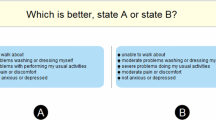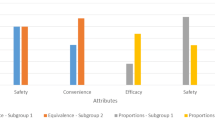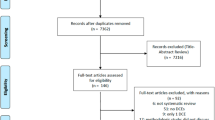Abstract
Objectives
In recent years, discrete choice experiments (DCEs) have become frequently used to generate utility values, but there are a diverse range of approaches to do this. The primary focus of this systematic review is to summarise the methods used for the design and analysis of DCEs when estimating utility values in both generic and condition-specific preference-based measures.
Methods
Published literature using DCEs to estimate utility values from preference-based instruments were identified from MEDLINE, Embase, Cochrane Library and CINAHL using PRISMA guidelines. To assess the different DCE methods, standardised information was extracted from the articles including the DCE design method, the number of choice sets, the number of DCE pairs per person, randomisation of questions, analysis method, logical consistency tests and techniques for anchoring utilities. The CREATE checklist was used to assess the quality of the studies.
Results
A total of 38 studies with samples from the general population, students and patients were included. Values for health states described using generic multi attribute instruments (MAUIs) (especially the EQ-5D) were the most commonly explored using DCEs. The studies showed considerable methodology and design diversity (number of alternatives, attributes, sample size, choice task presentation and analysis). Despite these differences, the quality of articles reporting the methods used for the DCE was generally high.
Conclusion
DCEs are an important approach to measure utility values for both generic and condition-specific instruments. However, a gold standard method cannot yet be recommended.

Similar content being viewed by others
References
Kluge, E.-H.W.: Resource allocation in healthcare: implications of models of medicine as a profession. Medscape Gen. Med. 9(1), 57–57 (2007)
Griffin, S., Claxton, K., Sculpher, M.: Decision analysis for resource allocation in health care. J. Health Serv. Res. Policy 13(3_suppl), 23–30 (2008). https://doi.org/10.1258/jhsrp.2008.008017
Drummond, M.F., Sculpher, M.J., Claxton, K., Stoddart, G.L., Torrance, G.W.: Methods for the economic evaluation of health care programmes. Oxford University Press, UK (2015)
Kularatna, S., Whitty, J.A., Johnson, N.W., Jayasinghe, R., Scuffham, P.A.: A comparison of health state utility values associated with oral potentially malignant disorders and oral cancer in Sri Lanka assessed using the EQ-5D-3 L and the EORTC-8D. Health Qual. Life Outcomes 14, 101 (2016). https://doi.org/10.1186/s12955-016-0502-y
Whitehead, S.J., Ali, S.: Health outcomes in economic evaluation: the QALY and utilities. Br. Med. Bull. 96(1), 5–21 (2010). https://doi.org/10.1093/bmb/ldq033
Gu, Y., Norman, R., Viney, R.: Estimating health state utility values from discrete choice experiments—a qaly space model approach. Health Econ. 23(9), 1098–1114 (2014). https://doi.org/10.1002/hec.3066
Krabbe, P.F., Devlin, N.J., Stolk, E.A., Shah, K.K., Oppe, M., van Hout, B., Quik, E.H., Pickard, A.S., Xie, F.: Multinational evidence of the applicability and robustness of discrete choice modeling for deriving EQ-5D-5L health-state values. Med. Care 52(11), 935–943 (2014). https://doi.org/10.1097/MLR.0000000000000178
Brazier, J., Roberts, J., Deverill, M.: The estimation of a preference-based measure of health from the SF-36. J. Health Econ. 21(2), 271–292 (2002)
Bjornson, K., McLaughlin, J.: The measurement of health-related quality of life (HRQL) in children with cerebral palsy. Eur. J. Neurol. 8(s5), 183–193 (2001)
Scuffham, P.A., Whitty, J.A., Mitchell, A., Viney, R.: The use of QALY weights for QALY calculations. PharmacoEconomics 26(4), 297–310 (2008)
McCabe, C., Brazier, J., Gilks, P., Tsuchiya, A., Roberts, J., O’Hagan, A., Stevens, K.: Using rank data to estimate health state utility models. J. Health Econ. 25(3), 418–431 (2006). https://doi.org/10.1016/j.jhealeco.2005.07.008
Ryan, M., Netten, A., Skåtun, D., Smith, P.: Using discrete choice experiments to estimate a preference-based measure of outcome—an application to social care for older people. J. Health Econ. 25(5), 927–944 (2006). https://doi.org/10.1016/j.jhealeco.2006.01.001
Rowen, D., Brazier, J., Van Hout, B.: A comparison of methods for converting DCE values onto the full health-dead QALY scale. Med. Decis. Making 35(3), 328–340 (2015). https://doi.org/10.1177/0272989X14559542
Lancsar, E., Wildman, J., Donaldson, C., Ryan, M., Baker, R.: Deriving distributional weights for QALYs through discrete choice experiments. J. Health Econ. 30(2), 466–478 (2011). https://doi.org/10.1016/j.jhealeco.2011.01.003
Ali, S., Ronaldson, S.: Ordinal preference elicitation methods in health economics and health services research: using discrete choice experiments and ranking methods. Br. Med. Bull. 103(1), 21–44 (2012)
Stolk, E.A., Oppe, M., Scalone, L., Krabbe, P.F.: Discrete choice modeling for the quantification of health states: the case of the EQ-5D. Value Health 13(8), 1005–1013 (2010). https://doi.org/10.1111/j.1524-4733.2010.00783.x
Brazier, J., Rowen, D., Yang, Y., Tsuchiya, A.: Comparison of health state utility values derived using time trade-off, rank and discrete choice data anchored on the full health-dead scale. Eur. J. Health Econ. 13(5), 575–587 (2012). https://doi.org/10.1007/s10198-011-0352-9
Ludwig, K., von der Schulenburg, J.G., Greiner, W.: Valuation of the EQ-5D-5L with composite time trade-off for the German population—an exploratory study. Health Qual. Life Outcomes 15(1), 39 (2017). https://doi.org/10.1186/s12955-017-0617-9
Craig, B.M., Busschbach, J.J.V.: Towards a more universal approach in health valuation. Health Econ. (2011). https://doi.org/10.1002/hec.1650
Clark, M.D., Determann, D., Petrou, S., Moro, D., de Bekker-Grob, E.W.: Discrete choice experiments in health economics: a review of the literature. PharmacoEconomics 32(9), 883–902 (2014)
Mulhern, B., Norman, R., Street, D.J., Viney, R.: One method, many methodological choices: a structured review of discrete-choice experiments for health state valuation. PharmacoEconomics 37(1), 29–43 (2019). https://doi.org/10.1007/s40273-018-0714-6
Mulhern, B., Norman, R., Lorgelly, P., Lancsar, E., Ratcliffe, J., Brazier, J., Viney, R.: Is dimension order important when valuing health states using discrete choice experiments including duration? PharmacoEconomics (2016). https://doi.org/10.1007/s40273-016-0475-z
King, M.T., Viney, R., Simon Pickard, A., Rowen, D., Aaronson, N.K., Brazier, J.E., Cella, D., Costa, D.S.J., Fayers, P.M., Kemmler, G., McTaggart-Cowen, H., Mercieca-Bebber, R., Peacock, S., Street, D.J., Young, T.A., Norman, R., On behalf of the, M.C.: Australian utility weights for the EORTC QLU-C10D, a multi-attribute utility instrument derived from the cancer-specific quality of life questionnaire, EORTC QLQ-C30. PharmacoEconomics 36(2), 225–238 (2018). https://doi.org/10.1007/s40273-017-0582-5
Bansback, N., Brazier, J., Tsuchiya, A., Anis, A.: Using a discrete choice experiment to estimate health state utility values. J. Health Econ. 31(1), 306–318 (2012). https://doi.org/10.1016/j.jhealeco.2011.11.004
Burr, J.M., Kilonzo, M., Vale, L., Ryan, M.: Developing a preference-based Glaucoma Utility Index using a discrete choice experiment. Optom. Vis. Sci. 84(8), 797–808 (2007). https://doi.org/10.1097/OPX.0b013e3181339f30
Ratcliffe, J., Brazier, J., Tsuchiya, A., Symonds, T., Brown, M.: Using DCE and ranking data to estimate cardinal values for health states for deriving a preference-based single index from the sexual quality of life questionnaire. Health Econ. 18(11), 1261–1276 (2009)
Moher, D., Liberati, A., Tetzlaff, J., Altman, D.: Preferred reporting items for systematic reviews and meta-analyses: the PRISMA statement. Ann. Intern. Med. 151(4), 264–269 (2009)
Xie, F., Pickard, A.S., Krabbe, P.F., Revicki, D., Viney, R., Devlin, N., Feeny, D.: A checklist for reporting valuation studies of multi-attribute utility-based instruments (CREATE). PharmacoEconomics 33(8), 867–877 (2015). https://doi.org/10.1007/s40273-015-0292-9
Bridges, J.F., Hauber, A.B., Marshall, D., Lloyd, A., Prosser, L.A., Regier, D.A., Johnson, F.R., Mauskopf, J.: Conjoint analysis applications in health—a checklist: a report of the ISPOR Good Research Practices for Conjoint Analysis Task Force. Value Health 14(4), 403–413 (2011). https://doi.org/10.1016/j.jval.2010.11.013
de Bekker-Grob, E.W., Ryan, M., Gerard, K.: Discrete choice experiments in health economics: a review of the literature. Health Econ. 21(2), 145–172 (2012)
Selivanova, A., Buskens, E., Krabbe, P.F.M.: Head-to-head comparison of EQ-5D-3L and EQ-5D-5L health values. PharmacoEconomics 36(6), 715–725 (2018). https://doi.org/10.1007/s40273-018-0647-0
Norman, R., Viney, R., Aaronson, N., Brazier, J., Cella, D., Costa, D., Fayers, P., Kemmler, G., Peacock, S., Pickard, A., Rowen, D., Street, D., Velikova, G., Young, T., King, M., Aaronson, N.K., Brazier, J.E., Costa, D.S.J., Fayers, P.M., Pickard, A.S.: Using a discrete choice experiment to value the QLU-C10D: feasibility and sensitivity to presentation format. Qual. Life Res. 25(3), 637–649 (2016). https://doi.org/10.1007/s11136-015-1115-3
Norman, R., Kemmler, G., Viney, R., Pickard, A.S., Gamper, E., Holzner, B., Nerich, V., King, M.: Order of presentation of dimensions does not systematically bias utility weights from a discrete choice experiment. Value Health 19(8), 1033–1038 (2016). https://doi.org/10.1016/j.jval.2016.07.003
Gamper, E.-M., Holzner, B., King, M.T., Norman, R., Viney, R., Nerich, V., Kemmler, G.: Test-retest reliability of discrete choice experiment for valuations of QLU-C10D health states. Value Health 21(8), 958–966 (2018). https://doi.org/10.1016/j.jval.2017.11.012
Huynh, E., Coast, J., Rose, J., Kinghorn, P., Flynn, T.: Values for the ICECAP-Supportive Care Measure (ICECAP-SCM) for use in economic evaluation at end of life. Soc. Sci. Med. 189, 114–128 (2017)
Xie, F., Pullenayegum, E., Pickard, A.S., Ramos Goñi, J.M., Jo, M.W., Igarashi, A., Jo, M.-W.: Transforming latent utilities to health utilities east does not meet west. Health Econ. 26(12), 1524–1533 (2017). https://doi.org/10.1002/hec.3444
Krabbe, P.F.M., Stolk, E.A., Devlin, N.J., Xie, F., Quik, E.H., Pickard, A.S.: Head-to-head comparison of health-state values derived by a probabilistic choice model and scores on a visual analogue scale. Eur. J. Health Econ. 18(8), 967–977 (2017)
Pullenayegum, E., Xie, F.: Scoring the 5-level EQ-5D: can latent utilities derived from a discrete choice model be transformed to health utilities derived from time tradeoff tasks? Med. Decis. Making 33(4), 567–578 (2013). https://doi.org/10.1177/0272989X13475718
Scalone, L., Stalmeier, P.F., Milani, S., Krabbe, P.F.: Values for health states with different life durations. Eur. J. Health Econ. 16(9), 917–925 (2015). https://doi.org/10.1007/s10198-014-0634-0
Ratcliffe, J., Flynn, T., Terlich, F., Stevens, K., Brazier, J., Sawyer, M.: Developing adolescent-specific health state values for economic evaluation: an application of profile case best-worst scaling to the Child Health Utility 9D. PharmacoEconomics 30(8), 713–727 (2012). https://doi.org/10.2165/11597900-000000000-00000
Prosser, L.A., Payne, K., Rusinak, D., Shi, P., Messonnier, M.: Using a discrete choice experiment to elicit time trade-off and willingness-to-pay amounts for influenza health-related quality of life at different ages. PharmacoEconomics 31(4), 305–315 (2013). https://doi.org/10.1007/s40273-013-0029-6
Purba, F., Hunfeld, J., Iskandarsyah, A., Fitriana, T., Sadarjoen, S., Ramos-Goñi, J., Passchier, J., Busschbach, J., Purba, F.D., Hunfeld, J.A.M., Fitriana, T.S., Sadarjoen, S.S., Ramos-Goñi, J.M., Busschbach, J.J.V.: The Indonesian EQ-5D-5L Value Set. PharmacoEconomics 35(11), 1153–1165 (2017). https://doi.org/10.1007/s40273-017-0538-9
Eckert, J., Lichters, M., Piedmont, S., Vogt, B., Robra, B.P.: Case vignettes based on EQ-5D to elicit stated preferences for health services utilization from the insurees' perspective. BMC Health Serv. Res. 15, 481 (2015). https://doi.org/10.1186/s12913-015-1143-2
Jonker, M.F., Donkers, B., de Bekker-Grob, E.W., Stolk, E.A.: Advocating a paradigm shift in health-state valuations: the estimation of time-preference corrected QALY tariffs. Value Health 21(8), 993–1001 (2018). https://doi.org/10.1016/j.jval.2018.01.016
Craig, B.M., Rand, K.: Choice defines QALYs: a US valuation of the EQ-5D-5L. Med. Care 56(6), 529–536 (2018). https://doi.org/10.1097/MLR.0000000000000912
Ramos-Goni, J.M., Rivero-Arias, O., Errea, M., Stolk, E.A., Herdman, M., Cabases, J.M.: Dealing with the health state 'dead' when using discrete choice experiments to obtain values for EQ-5D-5L heath states. Eur. J. Health Econ. 14(Suppl 1), S33–42 (2013). https://doi.org/10.1007/s10198-013-0511-2
Ramos-Goñi, J.M., Pinto-Prades, J.L., Oppe, M., Cabasés, J.M., Serrano-Aguilar, P., Rivero-Arias, O.: Valuation and modeling of EQ-5D-5L health states using a hybrid approach. Med. Care 55(7), e51–e58 (2017)
Bansback, N., Hole, A.R., Mulhern, B., Tsuchiya, A.: Testing a discrete choice experiment including duration to value health states for large descriptive systems: addressing design and sampling issues. Soc. Sci. Med. 114, 38–48 (2014). https://doi.org/10.1016/j.socscimed.2014.05.026
Mulhern, B., Shah, K., Janssen, M.F., Longworth, L., Ibbotson, R.: Valuing health using time trade-off and discrete choice experiment methods: does dimension order impact on health state values? Value Health 19(2), 210–217 (2016). https://doi.org/10.1016/j.jval.2015.11.005
Shiroiwa, T., Ikeda, S., Noto, S., Igarashi, A., Fukuda, T., Saito, S., Shimozuma, K.: Comparison of value set based on DCE and/or TTO data: scoring for EQ-5D-5L health states in Japan. Value Health 19(5), 648–654 (2016). https://doi.org/10.1016/j.jval.2016.03.1834
Versteegh, M.M., Brouwer, W.B.F.: Patient and general public preferences for health states: a call to reconsider current guidelines. Soc. Sci. Med. 165, 66–74 (2016). https://doi.org/10.1016/j.socscimed.2016.07.043
Huber, J., Zwerina, K.: The importance of utility balance in efficient choice designs. J. Market. Res. 307–317 (1996).
Vanniyasingam, T., Cunningham, C.E., Foster, G., Thabane, L.: Simulation study to determine the impact of different design features on design efficiency in discrete choice experiments. BMJ Open 6(7), e011985 (2016). https://doi.org/10.1136/bmjopen-2016-011985.
Hensher, D.A., Rose, J.M., Greene, W.H.: Applied choice analysis, 2nd edn. Cambridge University Press, UK (2015)
Kitamura, R., Yoshii, T., Yamamoto, T.: Expanding sphere of travel behaviour research: selected papers from the 11th international conference on travel behaviour research. Emerald Group Publishing, (2009)
De Martino, B., Harrison, N.A., Knafo, S., Bird, G., Dolan, R.J.: Explaining enhanced logical consistency during decision making in autism. J. Neurosci. 28(42), 10746–10750 (2008)
Arrow, K.J.: Risk perception in psychology and economics. Econ. Inq. 20(1), 1–9 (1982)
Norman, R., Cronin, P., Viney, R.: A pilot discrete choice experiment to explore preferences for EQ-5D-5L health states. Appl. Health Econ. Health Policy 11(3), 287–298 (2013). https://doi.org/10.1007/s40258-013-0035-z
Mulhern, B., Bansback, N., Hole, A.R., Tsuchiya, A.: Using discrete choice experiments with duration to model EQ-5D-5L health state preferences. Med. Decis. Making 37(3), 285–297 (2017). https://doi.org/10.1177/0272989X16670616
Lancsar, E., Louviere, J.: Deleting ‘irrational’ responses from discrete choice experiments: a case of investigating or imposing preferences? Health Econ. 15(8), 797–811 (2006). https://doi.org/10.1002/hec.1104
Hakim, Z.: Modelling the EuroQol data: a comparison of discrete choice conjoint and conditional preference modelling. Health Econ. 8(2), 103–116 (1999)
Lamers, L.M.: The transformation of utilities for health states worse than death: consequences for the estimation of EQ-5D value sets. Med. Care 45(3), 238–244 (2007)
Robinson, A., Spencer, A., Moffatt, P.: A framework for estimating health state utility values within a discrete choice experiment: modeling risky choices. Med. Decis. Making 35(3), 341–350 (2015)
Attema, A.E., Edelaar-Peeters, Y., Versteegh, M.M., Stolk, E.A.: Time trade-off: one methodology, different methods. Eur. J. Health Econ. 14(Suppl 1), 53–64 (2013). https://doi.org/10.1007/s10198-013-0508-x
Hauber, A.B., González, J.M., Groothuis-Oudshoorn, C.G.M., Prior, T., Marshall, D.A., Cunningham, C., Ijzerman, M.J., Bridges, J.F.P.: Statistical methods for the analysis of discrete choice experiments: a report of the ISPOR conjoint analysis good research practices task force. Value Health 19(4), 300–315 (2016). https://doi.org/10.1016/j.jval.2016.04.004
Acknowledgements
The research team would like to thank Saval Khanal and Emma (Tianjiao) Wang for their help on being the secondary readers of articles.
Funding
No funding was received for this study.
Author information
Authors and Affiliations
Contributions
MB, JB, RN, PS and MD conceived the study and contributed to the design of the study; MB wrote the first draft of the manuscript. All authors read, contributed and approved the manuscript.
Corresponding author
Ethics declarations
Conflict of interest
The authors declare that they have no conflict of interest.
Additional information
Publisher's Note
Springer Nature remains neutral with regard to jurisdictional claims in published maps and institutional affiliations.
Electronic supplementary material
Below is the link to the electronic supplementary material.
Rights and permissions
About this article
Cite this article
Bahrampour, M., Byrnes, J., Norman, R. et al. Discrete choice experiments to generate utility values for multi-attribute utility instruments: a systematic review of methods. Eur J Health Econ 21, 983–992 (2020). https://doi.org/10.1007/s10198-020-01189-6
Received:
Accepted:
Published:
Issue Date:
DOI: https://doi.org/10.1007/s10198-020-01189-6
Keywords
- Discrete choice experiment
- Conjoint analysis
- Health state valuation
- Preference-based measures
- Utility
- Systematic review




